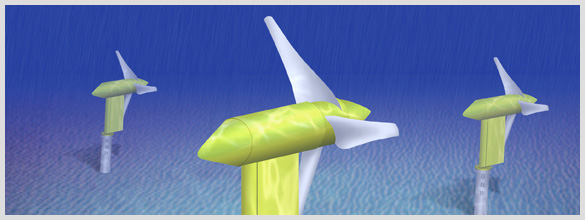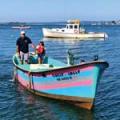Maine Maritime Academy - Tidal Power
By Janet Mendelsohn
 This figure shows an artist's conception of a possible turbine design based on traditional propeller technologies. Maine Maritime Academy's TEDEC would provide a location and the expertise to test various turbine configurations. This will help vendors bring their turbines to readiness for commercial application.
This figure shows an artist's conception of a possible turbine design based on traditional propeller technologies. Maine Maritime Academy's TEDEC would provide a location and the expertise to test various turbine configurations. This will help vendors bring their turbines to readiness for commercial application.
Image courtesy of Ripe Studios / Verdant Power
When Maine Maritime Academy in Castine announced in February 2007 that they had filed an application with the Federal Energy Regulation Commission (FERC) for a proposed Tidal Energy Device Evaluation Center (TEDEC), they knew it would take at least a year before a decision was announced. “Since then, we’ve answered their questions about the types of devices we anticipate testing and explained how this tidal power generation works,” said Mark Cote, professor and chair of MMA’s Engineering Department last fall. “FERC’s area of expertise is power generation using dams. This is the first application in the U.S. for the purposes we outlined, so we explained how the program will test generation of clean, renewable energy using tidal power. They are going through a learning curve. The application is moving forward but we don’t know when we’ll get a response.”
The response came in October 2007 when FERC issued a preliminary permit that allowed TEDEC to complete an evaluation of the river and its potential for their application. "If found to be acceptable," said Cote, "we likely will apply for a full permit sometime in 2009."
TEDEC would create a world-class facility to test and evaluate devices designed by U.S. and international companies. MMA students and faculty would be involved in research and educational opportunities at the proposed center, which is intended to facilitate and advance development of tidal energy. Ultimately it would generate electrical power for the academy’s campus and potentially supply excess electricity to Castine or the public power grid. The primary objective, though, is to advance technology in the area of tidal energy while improving understanding of the unique characteristics of the Bagaduce estuary and the potential impact of tidal energy devices on the environment, according to Cote.
MMA is the host institution representing a consortium of public and private agencies that currently includes three private companies: Cianbro Corporation, Marinus Power and OceanWorks International.
Two testing sites are proposed: one on the Bagaduce River, the other in Castine Harbor. “The Bagaduce Narrows produces high velocity flow but not a lot of volume, while in the harbor there is high volume but lower velocity,” said Cote. “The combination is one of the unique aspects to this proposal. We can test devices in both kinds of conditions.” No equivalent facility exists.
“With all of our sea entry points running north and south, and with our 10- to 20-foot tides, Maine provides especially good opportunities for generating tidal power. Its development has the potential for good new employment in the State of Maine,” said Cote. “If implemented, we know tidal power generation has the potential to impact the river, ecology and maritime operations. As a maritime school, we are committed to take all aspects of this into account. We think this is a great technology with a tremendous future for renewable power.”
 This figure shows an artist's conception of a possible turbine design based on traditional propeller technologies. Maine Maritime Academy's TEDEC would provide a location and the expertise to test various turbine configurations. This will help vendors bring their turbines to readiness for commercial application.
This figure shows an artist's conception of a possible turbine design based on traditional propeller technologies. Maine Maritime Academy's TEDEC would provide a location and the expertise to test various turbine configurations. This will help vendors bring their turbines to readiness for commercial application. Image courtesy of Ripe Studios / Verdant Power
Janet Mendelsohn is a freelance writer based in Maine and Massachusetts.
Related Articles
Share this article:
2023 Maine Boat & Home Show

Join Us for the Maine Boat & Home Show!
Art, Artisans, Food, Fun & Boats, Boats, Boats
August 11 - 13, 2023 | On the waterfront, Rockland, Maine
Click here to pre-order your tickets.
Show is produced by Maine Boats, Homes & Harbors magazine.















